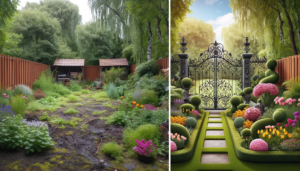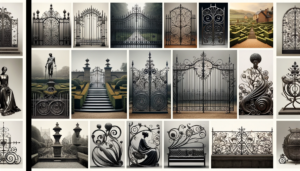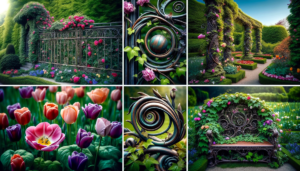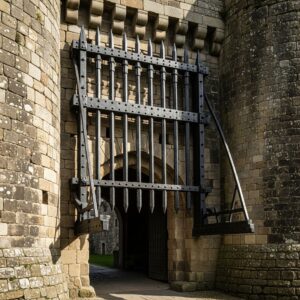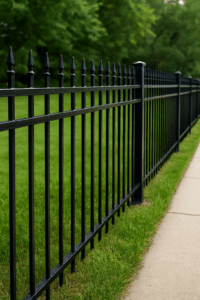The Timeless Elegance of Iron: From Historical Gardens to Modern Landscapes
Ironwork, with its intricate designs and enduring strength, has been a cornerstone in garden design for centuries. Historically, the use of iron in landscaping was not just a matter of aesthetics; it was a symbol of wealth and status. In the sprawling gardens of European aristocracy, ironwork was prominently displayed in the form of ornate gates, decorative fencing, and even whimsical sculptures. These historical landscapes showcased the artistry and craftsmanship of ironworkers, turning gardens into open-air galleries of metal art.
In the public parks of the 19th century, iron benches and gazebos became common, offering both functionality and beauty. These pieces were not only decorative but also served as focal points in the design of public and private gardens, illustrating the versatility of ironwork in various settings.
As we journey into the present, the role of ironwork in landscaping has evolved yet retained its core essence. Today, it merges traditional craftsmanship with contemporary design, offering a range of styles from minimalist to intricate. This evolution speaks to the timelessness of ironwork and its unique ability to adapt to changing tastes and architectural styles.
The Art of Ironwork in Garden Design
Tracing the Roots: The Historical Evolution of Ironwork in Garden Design
The journey of ironwork in garden design is as rich and intricate as the patterns often found in the iron itself. In ancient times, the use of iron was limited by its scarcity and the complexity of its production. However, as metallurgical techniques evolved, iron began to play a more prominent role in landscape design. During the Renaissance, European gardens started to feature iron elements more extensively. Elaborate gates and fencing became common in the estates of the nobility, each piece a testament to the ironworker’s skill and the garden owner’s status.
The Victorian era marked a significant shift in ironwork design. The industrial revolution made iron more accessible, leading to its widespread use in public and private gardens. This era saw the introduction of mass-produced yet intricately designed cast-iron elements, including benches, arbors, and even fountains. The designs ranged from the Gothic revival to the more organic Art Nouveau style, reflecting the changing tastes and artistic movements of the time.
Forging Ahead: Modern Trends and Styles in Ironwork for Landscaping
In contemporary garden design, ironwork has taken on a new life, blending traditional techniques with modern aesthetics. Today’s ironwork transcends mere functionality; it is a form of artistic expression that complements and enhances the natural beauty of the garden. Modern trends lean towards sleek, minimalist designs that suit urban environments, but there is also a resurgence of interest in bespoke, handcrafted pieces that echo the ornateness of the past.
Custom-made gates, sculptural pieces, and decorative screens are popular in modern gardens, often featuring abstract or geometric patterns. Ironwork is also being used in innovative ways, such as in vertical gardens or as frames for climbing plants, merging the organic with the metallic in a harmonious balance. The versatility of iron allows it to be incorporated into a wide range of garden styles, from classic to contemporary, making it a timeless choice for landscapers and homeowners alike.
Sustainability and eco-friendly practices are also becoming integral to modern ironwork, with a focus on using recycled materials and processes that reduce environmental impact. This shift not only appeals to environmentally conscious consumers but also adds another layer of meaning and relevance to ironwork in today’s garden designs.
Types of Ironwork Features for Your Garden
Decorative Fences and Gates: The First Impression
In the world of garden design, first impressions are vital, and nothing makes a statement quite like a beautifully crafted iron fence or gate. These elements serve as the welcoming arms of a garden, inviting visitors into a world of beauty and tranquility. Decorative fences not only provide security but also frame the garden, creating a visual boundary that enhances the overall aesthetic. Iron gates can range from simple and elegant designs to elaborate works of art, often reflecting the personality and style of the homeowner.
Iron Sculptures and Art Pieces: Adding a Personal Touch
Iron sculptures and art pieces in a garden are like the punctuation marks in a beautifully written poem. They add intrigue, evoke emotions, and give the garden a unique character. Whether it’s a whimsical animal figure, an abstract geometric form, or a classic statue, these pieces become focal points that draw the eye and invite closer inspection. Artistic ironwork can also serve as a conversation starter, adding a layer of personal expression to the landscape.
Functional Elements: Iron Benches, Arbors, and Gazebos
Beyond their aesthetic appeal, ironwork can also be deeply functional. Iron benches offer a place to sit and enjoy the beauty of the surroundings, blending durability with comfort. Arbors and gazebos crafted from iron not only provide structure for climbing plants but also create intimate spaces for relaxation and contemplation. These elements combine utility with beauty, making them essential components in a well-designed garden.
The Interplay of Ironwork with Plant Life
Choosing Plants that Complement Ironwork
The key to a harmonious garden is the thoughtful pairing of ironwork with the right plants. The robust, enduring nature of iron contrasts beautifully with the soft, ephemeral quality of plant life. When choosing plants to accompany ironwork, consider color, texture, and growth habit. For instance, the dark tones of ironwork can be beautifully offset by the vibrant greens of foliage or the bright hues of flowering plants. Climbing plants like ivy, roses, or wisteria can soften the hard lines of iron structures, creating a lush, intertwined display.
The Importance of Balance and Symmetry in Design
In garden design, balance and symmetry are not just about aesthetics; they’re about creating a sense of harmony and order. Ironwork, with its defined lines and structures, can help achieve this balance. When placed thoughtfully, iron elements can guide the eye through the garden, creating a sense of flow and symmetry. This balance is crucial in ensuring that the ironwork complements rather than overwhelms the natural elements of the garden.
Case Studies: Successful Garden Designs Combining Flora and Ironwork
Exploring successful case studies of gardens where ironwork and plant life are seamlessly integrated can provide valuable insights. These examples showcase the diversity of styles and approaches possible, from a minimalist urban terrace with sleek iron railings and potted plants to a sprawling country estate where ornate iron gazebos are engulfed in a riot of climbing roses. Each case study highlights the importance of considering both the architectural qualities of ironwork and the organic nature of plants to create a cohesive and enchanting garden space.
Durability and Maintenance of Ironwork
Ensuring Longevity: Tips for Selecting Quality Ironwork
The longevity of ironwork in your garden is significantly influenced by the quality of the materials and craftsmanship. When selecting ironwork, it’s important to consider factors like the thickness and grade of the metal, the type of joints used (welded or bolted), and the quality of the finish. A well-constructed iron piece, treated with weather-resistant coatings, can withstand the elements for years. Look for ironwork that has been galvanized or powder-coated, as these treatments offer superior protection against rust and corrosion.
Maintenance Tips to Prevent Rust and Wear
Even the highest quality ironwork requires regular maintenance to preserve its beauty and structural integrity. Here are some key tips:
- Regular cleaning: Wipe down ironwork with a mild soap and water solution to remove dirt and grime.
- Inspect for rust: Check for any signs of rust, especially in joints and crevices, and treat promptly with a rust-inhibiting primer and paint.
- Apply protective coatings: Periodically reapply protective sealants to guard against moisture and wear.
- Tighten loose fittings: Regularly check and tighten any bolts or fixtures to ensure stability.
By adhering to these maintenance practices, you can significantly extend the life of your ironwork, ensuring it remains a beautiful feature in your garden for years to come. Here‘s a great guide with more information.
DIY vs. Professional Installation of Ironwork
Pros and Cons of DIY Ironwork Projects
DIY ironwork projects can be appealing for those who enjoy hands-on work and have some experience in metalworking. The advantages of DIY include cost savings and the satisfaction of creating something with your own hands. However, it’s important to consider the challenges: ironwork requires specific tools and skills, such as welding and metal shaping. Additionally, DIY projects can be time-consuming and there’s always the risk of errors, which can compromise the safety and aesthetics of the installation.
When to Consider a Professional for Your Ironwork Needs
Professional installation is recommended for those who want assurance of quality, durability, and safety. Professionals bring expertise in design and installation, ensuring that the ironwork is not only aesthetically pleasing but also structurally sound and compliant with any local building codes. While more expensive than DIY, hiring a professional can save time and prevent costly mistakes. It’s especially advisable for complex projects or when working with large, heavy structures.
Conclusion
Throughout this exploration, we’ve delved into the fascinating world of ironwork in landscaping. From its historical roots to modern trends, ironwork has consistently proven its ability to transform garden spaces. The elegance and sophistication that iron features add to a landscape are unparalleled, offering a perfect blend of artistry and nature.
We encourage you to view ironwork not just as an addition to your garden, but as a creative expression that enhances the natural beauty of your outdoor space. Whether it’s through a simple iron bench or an elaborate gate, the inclusion of ironwork can make a significant impact, creating a garden that is both enchanting and unique.
Have you incorporated ironwork into your garden? What designs inspire you? We invite you to share your own photos and tales of how ironwork has transformed your garden.

